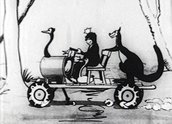
King Billy’s First Car (1939)
Synopsis
In this animated advertisement for Super Shell, King Billy invents an animal-made and animal-powered car.
Curator’s notes
King Billy’s First Car is a complex advertisement to negotiate for today’s viewer. It contains a very disturbing and offensive subtext about Indigenous Australians – discussed in detail in the Note from Sophia Sambono, NFSA Curator Indigenous Collections below these notes.
On one level the advertisement seems conceptually clever and witty – cartoon animals are elaborately deceived into manufacturing an improvised mode of transport for King Billy, and the animals themselves are incorporated into the design and function of the unorthodox vehicle. On another level, the cartoon animals are exploited and enslaved in the process of making the vehicle.
Inadvertently, this cartoon carries the message that progress incurs sacrifice – be it moral, economic, social or political. For a contemporary viewer, the advertisement offers a powerful reminder of the environmental and ecological impacts of our heavily motorised world. At the end, a motor vehicle fills up with Super Shell at a Shell petrol station. The accompanying voice-over announces ‘time marches on’, prompting us to wonder ‘but where does it lead us?’.
Advertisements reflect the social attitudes of the times and the changing ways companies promote and brand their products. We can see, when looking back at cinema advertisements over the decades, shifts in what society considers acceptable. The creative licence offered by the cartoon format gives the filmmakers a flexibility and scope not possible with live action.
The Shell Company of Australia – both as a private sponsor of films and self-contained production company, the Shell Film Unit – has been a sophisticated user of moving images since it started sponsoring films over 90 years ago. As with this animated advertisement, Shell’s productions demonstrate consistently high production values and creativity; and their messages are subtly, or not so subtly, related to their interests as an oil company.
The advertisement was animated by Melbourne artist, illustrator and cartoonist Dick Ovenden. Ovenden’s Billy Bear cartoon strips were a regular feature in the weekend supplements of The Argus newspaper during the 1940s.
King Billy’s First Car was one of several films screened by the Shell Company of Australia in a special program at His Majesty’s Theatre in Hobart on 2 March 1939.
Note from Sophia Sambono, Curator Indigenous Collections, NFSA
The ‘King Billy’ featured in this advertisement is an ape-like depiction of an Aboriginal man. There are many aspects of the animation which contribute to this portrayal: the contrast created by his white gloves, spats, king plate and exaggerated mouth (also a common feature of blackface) against the black skin and hair; the use of a crown; and the title ‘King Billy’.
‘King Billy’ does not indicate one particular person being represented; rather, it was a common and often arbitrary moniker given to many Aboriginal men who were singled out to act as a leader with whom authorities could communicate. This position was marked by a king plate. One such King Billy was Jimmy Clements who was present at the opening of Parliament House in Canberra, as seen in the film The Birth of White Australia (1928).
As Poppy mentions, the depiction serves as a powerful reminder to contemporary viewers, not just of environmental issues but of the inherent racism in society, reflecting the social attitudes of this time. Indeed Indigenous people in Australia were actually classified as flora and fauna right up until 1967.
Such comparisons with animals justified the poor treatment of minority groups across history; ape-like comparisons with black men, like those seen in the Shell ad, were used to justify slavery, violence and murder in America’s south. Unfortunately this ape stereotype is still not fully eradicated.
This attitude towards Aboriginal people can be seen in films such as Jedda (1955), where Jedda’s adoptive mother dismisses Aboriginal people as monkeys (see clip two).
In an advertising sense the use of an ape-like Aboriginal man infers that only primitive peoples use fuel other than Shell, and only primitive peoples would exploit animals this way.
- Overview
- Curator’s notes
- Video 1 clip
- Find a copy
- Make a comment
- Add your review



